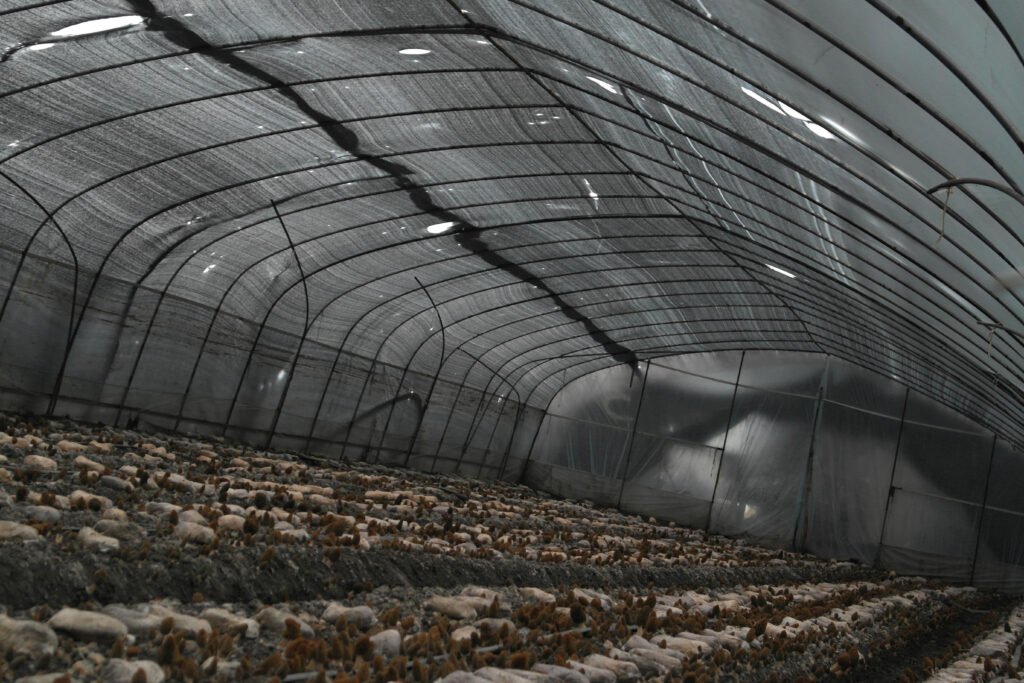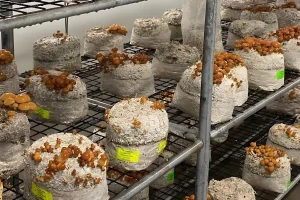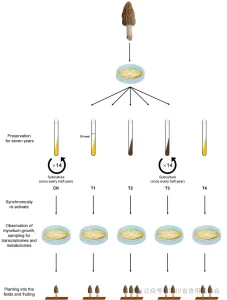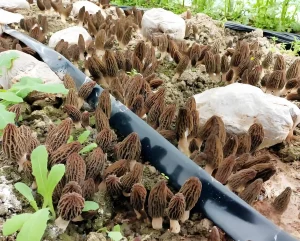Your Ultimate Guide to Profitable Cultivation
Are you ready to explore the lucrative world of large-scale mushroom farming? This comprehensive guide covers everything from the biology of mushrooms to setting up a profitable mushroom farm. Whether you’re a beginner or an experienced grower, learn how to cultivate edible mushrooms like Shiitake, Oyster, and Morel with precision and efficiency.

1. Introduction to Mushroom Farming
1.1 Why Mushroom Farming is a Profitable Business
Large-scale mushroom farming is more than just a business—it’s a sustainable way to generate substantial income while contributing to global food security. With growing demand for edible mushrooms in culinary and medicinal markets, this industry offers endless opportunities. Success requires a blend of scientific knowledge, controlled environments, and meticulous attention to detail.
1.2 Popular Edible Mushrooms and Their Cultivation Needs
From Shiitake (Lentinula edodes) to Oyster (Pleurotus spp.) and White Button (Agaricus bisporus), each mushroom species has unique growth requirements. Key factors like temperature, humidity, light exposure, and substrate type must be carefully managed to ensure a bountiful harvest.
2. The Science Behind Mushroom Growth
2.1 Understanding Mycelium and Fruiting Bodies
The mycelium—a network of thread-like hyphae—acts as the nutrient-absorbing engine of the mushroom. Under optimal conditions, it produces fruiting bodies, the edible part of the mushroom.
2.2 The Mushroom Life Cycle: From Spores to Harvest
Mushrooms begin as spores, which germinate into hyphae and form a mycelium network. When conditions are right, primordia (pins) emerge and mature into full-grown mushrooms ready for harvest.
2.3 Spores vs. Spawn: The Foundation of Mushroom Cultivation
While spores are the microscopic seeds of mushrooms, spawn is pre-colonized mycelium used to inoculate substrates. High-quality spawn is critical for successful cultivation.
3. Setting Up Your Mushroom Farm
3.1 Choosing the Perfect Location
Select a site with stable temperature, humidity, and light conditions. Proximity to markets and access to resources like water and electricity are also key considerations.
3.2 Indoor vs. Outdoor Farming: Which is Right for You?
Indoor farming offers year-round production and precise environmental control, while outdoor farming leverages natural resources for cost-effective cultivation.
3.3 Essential Equipment for Mushroom Farming
Invest in sterilization systems (e.g., autoclaves), substrate containers, climate control tools, and protective gear to ensure a smooth operation.
4. Preparing the Ideal Substrate
4.1 What is a Mushroom Substrate?
The substrate is the nutrient-rich base for mushroom growth. Common materials include straw, sawdust, wood chips, and manure.
4.2 How to Make Your Own Substrate
Chop, hydrate, and sterilize your substrate to create the perfect environment for mycelium colonization. Beginners can purchase pre-made substrates from trusted suppliers.
4.3 The Importance of Substrate Sterilization
Sterilization eliminates competing organisms, ensuring your mushrooms thrive. Methods include steam sterilization, chemical treatments, and pasteurization.
5. The Inoculation Process
5.1 Selecting High-Quality Spawn
Choose contaminant-free spawn from reputable suppliers or produce it in-house for better control over quality.
5.2 How to Inoculate Your Substrate
Introduce spawn into the substrate through layering or mixing, then seal it in bags or containers for colonization.
5.3 Maintaining Sterile Conditions
Use gloves, masks, and sterilized tools to prevent contamination during inoculation. A laminar flow hood can further ensure a clean environment.
6. Incubation and Colonization
6.1 Creating Optimal Conditions for Mycelium Growth
Maintain the right temperature, humidity, and darkness to encourage mycelium colonization.
6.2 Preventing and Managing Contamination
Regularly monitor for signs of mold or bacterial infections. Remove contaminated substrates immediately to protect your crop.
6.3 The Colonization Timeline
Colonization can take days to weeks, depending on the mushroom species. Look for white mycelium spreading across the substrate as a sign of progress.
7. Fruiting and Harvesting
7.1 Triggering Mushroom Fruiting
Adjust environmental conditions—such as light exposure, fresh air, and temperature—to stimulate fruiting body formation.
7.2 Monitoring Mushroom Development
Check daily to ensure proper growth. Maintain high humidity and adequate ventilation for healthy mushrooms.
7.3 Harvesting Your Mushrooms
Harvest when the caps are fully or partially open. Use a twist-and-pull or cut-at-the-base method to avoid damaging the mycelium.
8. Post-Harvest Handling
8.1 Cleaning and Storing Mushrooms
Gently remove substrate remnants and store mushrooms in a cool, ventilated area or refrigerate them to extend shelf life.
8.2 Exploring Market Opportunities
Sell fresh mushrooms or process them into dried mushrooms, powders, or extracts. Target local markets, restaurants, and online platforms for maximum reach.
9. Pest and Disease Management
9.1 Common Pests and Diseases
Watch out for mites, flies, molds, and bacterial infections that can harm your crop.
9.2 Prevention and Control Measures
Maintain a clean farm, use disease-free spawn, and apply approved pesticides or fungicides when necessary.
10. Sustainable Mushroom Farming Practices
10.1 Waste Management and Recycling
Compost used substrates and recycle water to minimize waste and reduce environmental impact.
10.2 The Environmental Benefits of Mushroom Farming
Mushrooms can grow on agricultural waste, improve soil health, and contribute to carbon sequestration.
11. Building a Successful Mushroom Farming Business
11.1 Market Research and Business Planning
Analyze market demand, competition, and pricing to create a solid business plan.
11.2 Marketing Strategies for Mushroom Farmers
Leverage farmers’ markets, local chefs, and online sales to promote your products. Highlight their health benefits and culinary versatility.
11.3 Scaling Your Operation
Expand your farm, invest in advanced equipment, and hire skilled workers to meet growing demand.
12. The Future of Mushroom Farming
12.1 Technological Advancements in the Industry
From automated climate control to AI-driven harvesting, technology is transforming mushroom farming.
12.2 Exploring New Mushroom Species and Applications
Stay ahead by researching new varieties and their potential in health, nutrition, and sustainability.
Start Your Mushroom Farming Journey Today!
Whether you’re growing Shiitake, Oyster, or Button mushrooms, this guide provides the tools and knowledge to succeed. Visit our website for more resources !
- 2025: The Year Agriculture Enters the AI Era – A New Wave of Transformation on the Horizon IAgricultural AI Revolution
- Algarikon Zero Project: How a Spanish Firm Transforms Invasive Algae for Edible Mushroom Cultivation
- 🔍 Research Uncovers Key Mechanisms of Morel Strain Degradation
- Spain: Edible Mushrooms Found to Alleviate the “Salty” Dilemma of the Meat Industry
- Yunnan’s Morel Mushroom Industry: Current Status and Prospects


